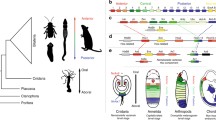Abstract
Seven Hox cluster-related genes (Dthox-A to -G) have been isolated from the freshwater triclad Dugesia (G.) tigrina, their sequence compared to other Hox genes and their expression in intact and regenerating organisms analyzed by whole mount in situ hybridization. Sequence comparison analyses show high similarities of D. tigrina Hox genes to anterior and medial groups of coelomate Hox genes. Expression analyses show very early, synchronous, and overlapping expression of Dthox -A, -E, -G and -F in anterior, posterior and lateral regenerative tissues. At one hour of regeneration all Dthox genes studied showed a neat, clear expression at the wound boundary. Later, as the blastema grows, the expression area expands to more proximal regions covering the blastema and the distal postblastema regions. Blastemas formed by intercalary regeneration also show a synchronous expression of the same Hox genes though the onset of activation is much delayed. The finding that the same set of Hox genes is synchronously activated in anterior, posterior, intercalary and lateral regeneration is in sharp contrast to its well established role in specifying antero-posterior pattern during embryonic development. The implications of these results as regards ancestral versus co-opted roles of Hox genes in development and regeneration are discussed.
Similar content being viewed by others
References
Averof, M. & M. Akam, 1995. Hox genes and the diversification of insect and crustacean body plans. Nature 376: 420–423.
Baguñà, J., 1981. Planarian neoblasts. Nature 290: 14–15.
Baguñà, J., E. Saló & M. C. Auladell, 1989. Regeneration and pattern formation in planarians. III. Evidence that neoblasts are totipotent stem cells and the source of blastema cells. Development 107: 77–86.
Baguñà, J., E. Saló, R. Romero, J. Garcia-Fernàndez, D. Bueno, A. Muñoz-Mármol, J. R. Bayascas-Ramírez & A. Casali, 1994. Regeneration and pattern formation in planarians: cells, molecules and genes. Zool. Sci. 11: 781–795.
Balavoine G., 1997. The early emergence of platyhelminths is contradicted by the agreement between 18S rRNA and Hox genes data. C.r. Acad. Sci., Paris 320: 83–94.
Bayascas JR, E. Castillo, A.M. Muñoz-Mármol, E. Saló, 1997. Planarian Hox genes: novel patterns of expression during regeneration. Development 124: 141–148.
Brønsdted, H. V., 1969. Planarian Regeneration. Pergamon Press, London.
Carroll, S. B., 1995. Homeotic genes and the evolution of arthropods and chordates. Nature 376: 478–485.
Deveraux JP, P. Haeberli, O. Smithies, 1984. A comprehensive set of sequence analysis programs for the VAX. Nucl. Acids Res. 12: 387–395.
Duboule, D., 1994. Temporal colinearity and the phylotypic progression: a basis for the stability of a vertebrate Bauplan and evolution of morphologies through heterochrony. Development Suppl., 135–142.
Gardiner, D. M., B. Blumberg, Y. Komine & S. V. Bryant, 1995. Regulation of Hox-A expression in developing and regenerating axolotl limbs. Development 121: 1731–1741.
Gardiner, D.M. & S. V. Bryant, 1996. Molecular mechanisms in the control of limb regeneration: the role of homeobox genes. Int. J. Dev. Biol 40: 797–805.
Holland, P. W. H., 1993. Cloning genes using the polymerase chain reaction. In C. D. Stern & P. W. H. Holland (eds), Essential Developmental Biology. A Practical Approach. IRL Press, Oxford: 243–255.
Kenyon, C., 1994. If birds can fly, why can't we? Homeotic genes and evolution. Cell 78: 175–180.
Krumlauf, R., 1994. Hox genes in vertebrate development. Cell 78: 191–201.
Lawrence, P. A. & G. Morata, 1994. Homeobox genes: their function in Drosophila segmentation and pattern formation. Cell 78: 181–189.
Ribas, M., M. Riutort & J. Baguñà, 1989. Morphological and biochemical variation in populations of Dugesia (G.) tigrina (Turbellaria, Tricladida, Paludicola) from the western Mediterranean: biogeographical and taxonomical implications. J. Zool., London 218: 609–626.
Saló, E. & J., Baguñà, 1984. Regeneration and pattern formation in planarians. I. The pattern of mitosis in anterior and posterior regeneration inDugesia (G.) tigrina, and a new proposal for blastema formation. J. Embryol. exp. Morph. 83: 63–80.
Saló, E. & J., Baguñà, 1985. Proximal and distal transformation during intercalary regeneration in the planarian Dugesia (G) tigrina. Roux's Arch. Dev. Biol. 194: 364–368.
Saló, E. & J. Baguñà. 1989. Regeneration and pattern formation in planarians. II. Local origin and role of cell movements in blastema formation. Development 107: 69–76.
Saló, E., A. M. Muñoz-Mármol, J. R. Bayascas-Ramirez, J. Garcia-Fernàndez, A. Miralles, A. Casali, M. Corominas & J. Baguñà, 1995. The freshwater planarian Dugesia (G.) tigrina contains a great diversity of homeobox genes. Hydrobiologia 305: 269–275.
Tauler J, Baguñà J, E. Saló, J. Garcia-Fernàndez, 1996. Distox genes: A milestone in the evolution of HOX clusters? Int. J. Dev. Biol. Suppl. 1: 69S.
Author information
Authors and Affiliations
Corresponding author
Rights and permissions
About this article
Cite this article
Bayascas, J.R., Castillo, E., Muñoz-Mármol, A. et al. Synchronous and early activation of planarian Hox genes and the re-specification of body axes during regeneration in Dugesia (G.) tigrina (Turbellaria; Tricladida). Hydrobiologia 383, 125–130 (1998). https://doi.org/10.1023/A:1003427408356
Issue Date:
DOI: https://doi.org/10.1023/A:1003427408356




